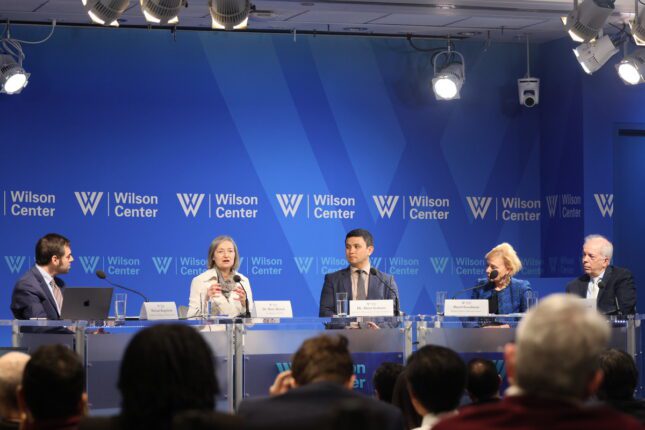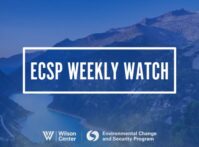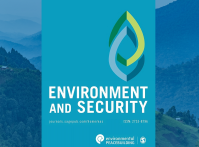-
Water @ Wilson | MODSNOW: A New Tool for Water Security in Central and South Asia
March 28, 2024 By Wilson Center Staff
Central and South Asia’s water resources are critical for the region’s water, energy, food and environmental security. Major rivers in the region originate from the Hindu-Kush-Himalaya, Pamir, and Tien Shan Mountain Ranges and flow across multiple countries. Unique geographical characteristics make water management a complex and challenging task that is further complicated by a changing climate and increasing demand affecting diminishing water resources.
At this Wilson Center event, policymakers and leaders in the water security space shared insights about water security in the region and the importance of the MODSNOW tool, a free, USAID-supported software package that supports better prediction of water availability and ultimately contributes to effective water management.
Select quotes from the panel are featured below.
Änjali Kaur, Deputy Assistant Administrator, Asia Bureau, U.S. Agency for International Development, on USAID’s efforts to support the creation of this tool.
In response to [the] daunting challenge [of climate change], we have been at the forefront of harnessing technology to safeguard water security in some of the most vulnerable regions of the world. We’re proud to have partnered with Integra to develop the simple yet remarkably effective MODSNOW, designed to empower governments and communities in Asia to monitor water flows originating from high mountains. This is critical not only for the immediate needs of the present, but also for the long term sustainability and prosperity of future generations.
Ambassador Sridhar Khatri, Ambassador of Nepal to the U.S, on Nepal’s water security
Almost every sector of the economy of Nepal is directly linked to the Himalayas. Nepal’s present and future economy and prospects for greater prosperity depends on the preservation and management of the precious water resources of the Himalayas. Unfortunately, [the mountain range is seeing] alarming signs of rapid melting of snow.
Considering these adverse effects of climate change, Nepal has adopted the GRID policy, prioritizing green resilient and inclusive development. This initiative, along with the application of the MODSNOW tool developed by Dr. Abror Gafurov, will provide real time information of water resources and help us to better prepare for disaster response. It will also be of great value in terms of planning for irrigation, hydropower generation and water supply of the entire region… We look forward to deepening our interaction with development partners like the United States in achieving water security, not only for Nepal, but for the rest of South Asia as well.
Ambassador Farrukh Hamralizoda, Ambassador of Tajikistan to the United States, on Tajikistan’s water security
In face of the ongoing climate crisis, it’s crucial for world leaders, governments and institutions to take swift actions, adopt forward thinking approaches, embrace innovation, and drive transformative change. Effective water resource management for sustainable development requires collecting, interpreting, and applying data and information in relation to the water resources, building capacity to conduct water resources, and assessment & monitoring.
Ambassador Baktybek Amanbaev, Ambassador of the Kyrgyz Republic to the United States on the Kyrgyz Republic’s water security
A key promising and profitable area for the Kyrgyz Republic is hydropower. 90% of our country is covered by mountains, 30% of the former Soviet water resources are located in the Kyrgyz republic. Our hydropower potential can produce 150 billion kilowatt hours of energy per year. But, unfortunately, because of climate change, our mountain glaciers have begun to melt rapidly. So we need effective water management. MODSNOW provides us with the necessary information to forecast availability, [and] it holds key information needed to effectively manage water resources on a national level.
Abror Gafurov, creator of MODSNOW, on the impacts of the tool
The MODSNOW tool is a new tool for water security in Central and South Asia. Water is a source of peace and prosperity in Central and South Asia. USAID and Integra have enhanced MODSNOW for improved real time monitoring of water resources. We also deliver training on the tool in seven countries of Central and South and Central Asia. The [tool] allows better management of water resources in South and Central Asia. It helps to predict the unpredictable, for example droughts and other natural hazards. It also delivers real time information on water supply from source areas.
Michael Kugelman, Director of the South Asia Program at the Wilson Center introduces the panel
I think it’s easy for analysts, particularly those outside the regions in question, to fixate on the many policy challenges of the moment, whether they’re political, economic, legal, or security. Water insecurity and indeed the future prospect of water scarcity is the urgent issue that is so often overlooked, or set aside. It is often an elephant in the room that really should not be.
Eric Rudenshiold, Senior Fellow for Caspian Affairs at the Caspian Policy Center, on why measuring water scarcity is so critical
If you go back [to] 5 or 10 years ago, these countries wouldn’t talk to each other about the issue–and now you actually are seeing countries working together [and] cooperating with each other on trans boundary water issues. When you look at all of Central Asia in particular, the one thing that screams at you is that water in this region is receding. The water supply in the region has declined by four times the level of the 1960s.
Increasing sections of Central Asia are becoming unsustainable to sustain human life… And I think tools like MODSNOW are absolutely critical for us at this point in time to help governments be able to help moderate and address water usage issues.
Sherri Goodman, Senior Fellow at the Wilson Center Polar Institute and ECSP, on the stability implications of water insecurity
I coined the phrase “threat multiplier” to characterize the linkage between climate change and security that climate would act as an accelerated [destabilizing factor]. When the US national security strategy talks about climate being the most existential threat we face and one that poses a risk to stability, we can see how based on the evidence that Eric has shared with us about how changes in the glacial melt the changes in water availability, increasing water scarcity, and shortage across the region, are are all factors that can lead to potentially increased conflict and instability.
Mary Melnick, Environmental Security and Resilience Division Chief, Asia Bureau, U.S. Agency for International Development, ends on a call to action
Each of us as individuals need to work and look at our decisions and choices every day and the impacts they have on climate. Looking at our professional positions, consider how now knowing what you know, how within your other areas of portfolios, is this important, and how can you become climate positive? Governments are moving and acting as we clearly saw this morning. There are future areas beyond the tool that are going to be very valuable areas to look at innovative technologies and water management. I think the challenge is all of ours is a shared challenge, and there’s something we can all do.
Photo credit: photo of the panelists at the event, courtesy of the Wilson Center media team.
 A Publication of the Stimson Center.
A Publication of the Stimson Center.







